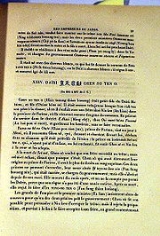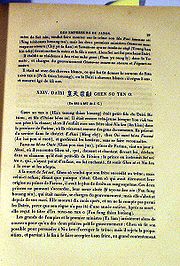
Emperor Kenzo
Encyclopedia
, also spelled Ghen-so-tennō, was the 23rd emperor
of Japan
, according to the traditional order of succession.
No firm dates can be assigned to this emperor's life or reign, but he is conventionally considered to have reigned from 485–487.
, and the son of Ichinobe-no Oshiwa. He would have been quite young when Emperor Yūryaku
shot the arrow which killed his father during a hunting expedition; and this caused both Prince Oke and his older brother, Prince Ōka, to flee for their lives. They found refuge at Akashi
in Harima province
where they hid by living in obscurity. Histories from that period explained that the two brothers sought to blend into this rural community by posing as common herdsmen.
It is said that the Prince of Harima came by chance to Akashi; and at that time, Prince Ōka revealed his true identity. This intermediary re-introduced the lost cousins to Emperor Seinei
, who had by this time ascended to the throne after the death of his father, the former Emperor Yūryaku. Seinei invited both brothers to return the court; and he adopted both of them as sons and heirs.
At Seinei's death, he had no other heirs than Prince Ōka and Prince Oka, whose father had been killed by Yūraku. At this point, Oka wanted his elder brother to become emperor; but Ōke refused. The two could not reach an agreement. The great men of the court insisted that one or the other of the brothers must accept the throne; but in the end, Ōka proved to be more adamant. Prince Oka agreed to accept the throne; and Kenzō was ultimately proclaimed as the new emperor—which created a sense of relief for all the people who had endured this period of uncertainty.
 Kenzō is considered to have ruled the country during the late-5th century, but there is a paucity of information about him. There is insufficient material available for further verification and study.
Kenzō is considered to have ruled the country during the late-5th century, but there is a paucity of information about him. There is insufficient material available for further verification and study.
Kenzō's contemporary title would not have been tennō, as most historians believe this title was not introduced until the reigns of Emperor Tenmu and Empress Jitō
. Rather, it was presumably Sumeramikoto or Amenoshita Shiroshimesu Ōkimi (治天下大王), meaning "the great king who rules all under heaven." Alternatively, Kenzō might have been referred to as (ヤマト大王/大君) or the "Great King of Yamato."
. The location of the palace is thought to have been in present day Osaka prefecture
or Nara prefecture
.
Murray reports that the only event of major consequence during Kenzō's reign had to do with the filial respect he showed for his murdered father. Kenzō arranged to have his father's remains retrieved and reinterred in a mausoleum appropriate for the son of an one Emperor and the father of another.
Kenzō died at age 38, reigning only three years. He too had no other heirs; so this emperor's brother would follow him on the throne.
The actual site of Kenzō's grave
is not known. This emperor is traditionally venerated at a memorial
Shinto
shrine
(misasagi) at Osaka
.
The Imperial Household Agency
designates this location as Kenzō's mausoleum
. It is formally named Kataoka no Iwatsuki no oka no kita no misasagi.
Emperor
An emperor is a monarch, usually the sovereign ruler of an empire or another type of imperial realm. Empress, the female equivalent, may indicate an emperor's wife or a woman who rules in her own right...
of Japan
Japan
Japan is an island nation in East Asia. Located in the Pacific Ocean, it lies to the east of the Sea of Japan, China, North Korea, South Korea and Russia, stretching from the Sea of Okhotsk in the north to the East China Sea and Taiwan in the south...
, according to the traditional order of succession.
No firm dates can be assigned to this emperor's life or reign, but he is conventionally considered to have reigned from 485–487.
Legendary narrative
Prince Oka, later to become Emperor Kenzō, is said to have been the grandson of Emperor RichūEmperor Richu
was the 17th emperor of Japan, according to the traditional order of succession.No firm dates can be assigned to this emperor's life or reign, but he is conventionally considered to have reigned from 400–405.-Legendary narrative :...
, and the son of Ichinobe-no Oshiwa. He would have been quite young when Emperor Yūryaku
Emperor Yuryaku
was the 21st emperor of Japan, according to the traditional order of succession.Yūryaku is remembered as a patron of sericulture.No firm dates can be assigned to this emperor's life or reign, but he is conventionally considered to have reigned from 456–479....
shot the arrow which killed his father during a hunting expedition; and this caused both Prince Oke and his older brother, Prince Ōka, to flee for their lives. They found refuge at Akashi
Akashi
-People:*Akashi Ken*Akashi Momoka*Akashi Morishige*Akashi Motojiro*Akashi Shiganosuke*Akashi Yasushi-Places:*Akashi, Hyōgo*Akashi Station - Japanese railroad station on the Sanyō Main Line*Akashi-Kaikyō Bridge*Akashi Castle*Akashi Domain-Other:...
in Harima province
Harima Province
or Banshu was a province of Japan in the part of Honshū that is the southwestern part of present-day Hyōgo Prefecture. Harima bordered on Tajima, Tamba, Settsu, Bizen, and Mimasaka Provinces. Its capital was Himeji....
where they hid by living in obscurity. Histories from that period explained that the two brothers sought to blend into this rural community by posing as common herdsmen.
It is said that the Prince of Harima came by chance to Akashi; and at that time, Prince Ōka revealed his true identity. This intermediary re-introduced the lost cousins to Emperor Seinei
Emperor Seinei
was the 22nd emperor of Japan, according to the traditional order of succession.No firm dates can be assigned to this emperor's life or reign, but he is conventionally considered to have reigned from 480–484.-Legendary narrative:...
, who had by this time ascended to the throne after the death of his father, the former Emperor Yūryaku. Seinei invited both brothers to return the court; and he adopted both of them as sons and heirs.
At Seinei's death, he had no other heirs than Prince Ōka and Prince Oka, whose father had been killed by Yūraku. At this point, Oka wanted his elder brother to become emperor; but Ōke refused. The two could not reach an agreement. The great men of the court insisted that one or the other of the brothers must accept the throne; but in the end, Ōka proved to be more adamant. Prince Oka agreed to accept the throne; and Kenzō was ultimately proclaimed as the new emperor—which created a sense of relief for all the people who had endured this period of uncertainty.

Kenzō's contemporary title would not have been tennō, as most historians believe this title was not introduced until the reigns of Emperor Tenmu and Empress Jitō
Empress Jito
was the 41st emperor of Japan, according to the traditional order of succession.Jitō's reign spanned the years from 686 through 697.In the history of Japan, Jitō was the third of eight women to take on the role of empress regnant. The two female monarchs before Jitō were Suiko and Kōgyoku/Saimei...
. Rather, it was presumably Sumeramikoto or Amenoshita Shiroshimesu Ōkimi (治天下大王), meaning "the great king who rules all under heaven." Alternatively, Kenzō might have been referred to as (ヤマト大王/大君) or the "Great King of Yamato."
Kenzō's reign
It is recorded that his capital was at in Yamato provinceYamato Province
was a province of Japan, located in Kinai, corresponding to present-day Nara Prefecture in Honshū. It was also called . At first, the name was written with one different character , and for about ten years after 737, this was revised to use more desirable characters . The final revision was made in...
. The location of the palace is thought to have been in present day Osaka prefecture
Osaka Prefecture
is a prefecture located in the Kansai region on Honshū, the main island of Japan. The capital is the city of Osaka. It is the center of Osaka-Kobe-Kyoto area.- History :...
or Nara prefecture
Nara Prefecture
is a prefecture in the Kansai region on Honshū Island, Japan. The capital is the city of Nara.-History:The present-day Nara Prefecture was created in 1887, making it independent of Osaka Prefecture....
.
Murray reports that the only event of major consequence during Kenzō's reign had to do with the filial respect he showed for his murdered father. Kenzō arranged to have his father's remains retrieved and reinterred in a mausoleum appropriate for the son of an one Emperor and the father of another.
Kenzō died at age 38, reigning only three years. He too had no other heirs; so this emperor's brother would follow him on the throne.
The actual site of Kenzō's grave
Grave (burial)
A grave is a location where a dead body is buried. Graves are usually located in special areas set aside for the purpose of burial, such as graveyards or cemeteries....
is not known. This emperor is traditionally venerated at a memorial
Memorial
A memorial is an object which serves as a focus for memory of something, usually a person or an event. Popular forms of memorials include landmark objects or art objects such as sculptures, statues or fountains, and even entire parks....
Shinto
Shinto
or Shintoism, also kami-no-michi, is the indigenous spirituality of Japan and the Japanese people. It is a set of practices, to be carried out diligently, to establish a connection between present day Japan and its ancient past. Shinto practices were first recorded and codified in the written...
shrine
Shrine
A shrine is a holy or sacred place, which is dedicated to a specific deity, ancestor, hero, martyr, saint, daemon or similar figure of awe and respect, at which they are venerated or worshipped. Shrines often contain idols, relics, or other such objects associated with the figure being venerated....
(misasagi) at Osaka
Osaka
is a city in the Kansai region of Japan's main island of Honshu, a designated city under the Local Autonomy Law, the capital city of Osaka Prefecture and also the biggest part of Keihanshin area, which is represented by three major cities of Japan, Kyoto, Osaka and Kobe...
.
The Imperial Household Agency
Imperial Household Agency
The is a government agency of Japan in charge of the state matters concerning Japan's imperial family and also keeping the Privy Seal and the State Seal...
designates this location as Kenzō's mausoleum
Mausoleum
A mausoleum is an external free-standing building constructed as a monument enclosing the interment space or burial chamber of a deceased person or persons. A monument without the interment is a cenotaph. A mausoleum may be considered a type of tomb or the tomb may be considered to be within the...
. It is formally named Kataoka no Iwatsuki no oka no kita no misasagi.

